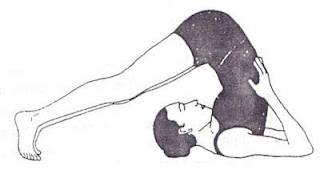Lotus Pose (Padmasana) पद्मासन : विधि
और लाभ
संस्कृत में पद्म का मतलब होता हैं 'कमल' और आसन का मतलब होता हैं 'बैठना'। पद्मासन में बैठने के बाद शरीर का आकार कमल के समान होने के कारण पद्मासन को कमलासन यह नाम भी दिया गया हैं। अंग्रेजी में इसे Lotus Pose कहा जाता हैं। पद्मासन यह सामान्यतः ध्यान में बैठने के लिए सर्वमान्य पद्धति हैं।
Padma
= Lotus, asana = posture or pose Pronounced
: Pa-dah-maa-sun-aa
Padmasana
or Lotus pose is a cross-legged yoga posture which helps deepen meditation by
calming the mind and alleviating various physical ailments. A regular practice
of this posture aids in overall blossoming of the practitioner, just like a
lotus; and hence the name Padmasana.
पद्मासन की विधि और लाभ संबंधी अधिक जानकारी निचे दी गयी हैं :
पद्मासन की विधि और लाभ संबंधी अधिक जानकारी निचे दी गयी हैं :
पद्मासन : विधि और लाभ
|
पद्मासन विधि
· एक स्वच्छ और समतल जगह पर दरी या चटाई बिछा दे।
· पैरों को सामने की ओर सीधा फैलाकर बैठ जाए।
· अब धीरे-धीरे एक पैर को घुटने से मोड़कर पंजे को दुसरे पैर की जांघ (Thigh) पर रखे।
· अब दुसरे पैर घुटनों से मोड़कर पहले पैर की जांघ पर रखे।
· पैर के तलवों की दिशा पेट की ओर होनी चाहिए।
· दोनों पैर के घुटनों का स्पर्श जमीन से होना चाहिए। अभ्यास के साथ आप यह स्तिथि प्राप्त कर सकते हैं।
· सिर, मेरुदंड सीधा रखे।
· दोनों हाथो को कुंहनियो से मोड़कर घुटनों पर रखे।
· आप चाहे तो हाथों से ज्ञानमुद्रा
या चिनमुद्रा धारण कर सकते हैं।
· कंधो को सीधा रखे
· आँखों को बंद करे और सामान्य श्वसन करे।
How to perform Lotus Pose (Padmasana)
- Sit on the floor or on a mat with legs stretched out in
front of you while keeping the spine erect.
- Bend the right knee and place it on the left thigh.
Make sure that the sole of the feet point upward and the heel is close to
the abdomen.
- Now, repeat the same step with the other leg.
- With both the legs crossed and feet placed on opposite
thighs, place your hands on the knees in mudra position.
- Keep the head straight and spine erect.
- Hold and continue with gentle long breaths in and out.
Mudras for Lotus Pose (Padmasana)
Mudras stimulate the flow of energy in body and can
have amazing effects when practiced with Padmasana. Every mudra differs from
each other and so do their benefits. When sitting in Padmasana, you can deepen
your meditation by incorporating either Chin mudra, Chinmayi mudra, Adi mudra
or Bhrama mudra. Breathe for a few minutes while in the mudra and observe the
flow of energy in the body.
Lotus Pose (Padmasana) for Beginners
If you have problem overlapping both your legs
and sitting in Padmasana, you may also sit in Ardha – Padmasana (Half – Lotus
pose) by placing any one leg on the opposite thigh. Continue doing so till you
feel flexible enough to progress to Padmasana.
पद्मासन में सावधानी बरते ?
निचे दिए हुए रोगों से पीड़ित व्यक्तिओ ने पद्मासन नहीं करना चाहिए :
· गृध्रसी (Sciatica)
· संधिवात (Osteo Arthritis)
· घुटनों में सुजन
· घुटनों में अत्याधिक कडापन
· कमरदर्द
पद्मासन के लाभ
· मन को शांत करता हैं
· तनाव में कमी
· एकाग्रता बढाता हैं
· मेरुदंड को सीधा, लचीला और मजबूत बनाता हैं
· ध्यान (Meditation) करने के लिए श्रेष्ठ स्तिथि
· रक्तचाप में नियंत्रण
· पद्मासन का नियमित अभ्यास करने से पेट और जांघ पर जमी अतिरिक्त चर्बी कम हो जाती हैं
पद्मासन करते समय शरुआत में परेशानी हो सकती हैं इसलिए अभ्यास के साथ इसका समय बढाये। पद्मासन करते समय कोई तकलीफ होने पर योग विशेषज्ञ की सलाह लेनी चाहिए।
Benefits of the Lotus Pose (Padmasana)
·
Improves
digestion
·
Reduces
muscular tension and brings blood pressure under control
·
Relaxes
the mind
·
Helps
pregnant ladies during childbirth
·
Reduces
menstrual discomfort
Contraindications of the Lotus Pose (Padmasana)
Ankle or knee injury: Perform
this pose only with the supervision of an experienced teacher.
Follow-up Poses
Padmasana can be followed up
with Adho-Mukho Svanasana.
Yoga
practice helps develop the body and mind bringing a lot of health benefits yet
is not a substitute for medicine. It is important to learn and practice yoga
postures under the supervision of a trained Yoga teacher. In case of any
medical condition, practice yoga postures after consulting a doctor and a Yoga
teacher. Find a Yoga course at near you. Do you need information on courses or
share feedback? Write to us at yogawithanu@gmail.com




